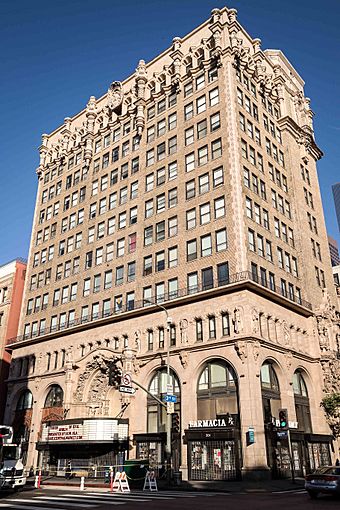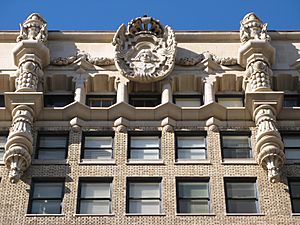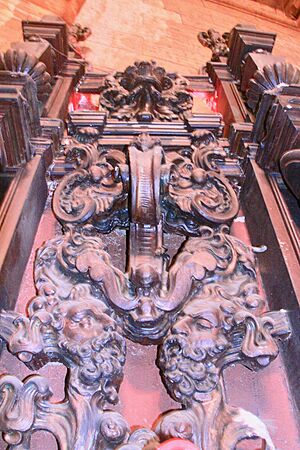Million Dollar Theatre facts for kids

The Spanish Baroque Revival exterior
|
|
| Address | 307 S. Broadway |
|---|---|
| Location | Los Angeles, California |
| Coordinates | 34°3′2.98″N 118°14′53.29″W / 34.0508278°N 118.2481361°W |
| Public transit | |
| Owner | Langdon Street Capital |
| Type | Movie palace |
| Capacity | 2,041 |
| Construction | |
| Built | 1917 |
| Architect | Albert C. Martin Sr. |
| Designated: | July 2, 2019 |
| Reference #: | 1184 |
| Designated: | May 9, 1979 |
| Part of: | Broadway Theater and Commercial District |
| Reference #: | 79000484 |
| Designated: | July 20, 1978 |
| Reference #: | 78000687 |
The Million Dollar Theatre is a famous movie palace in Downtown Los Angeles. It is located at 307 S. Broadway. This theater was one of the very first grand movie palaces built in the United States.
It first opened its doors in 1917. The first movie shown there was The Silent Man. The Million Dollar Theatre is the northernmost of many historic movie palaces. These theaters are all part of the Broadway Theater and Commercial District. The theater is also right across from the well-known Bradbury Building. It is listed on the National Register of Historic Places.
Contents
History of the Million Dollar Theatre
The Million Dollar Theatre was the first movie house built by a man named Sid Grauman. He opened it in 1918. It was the first really grand cinema palace in Los Angeles. Sid Grauman later built other famous theaters. These include Grauman's Egyptian Theatre and Grauman's Chinese Theatre. Both of these are on Hollywood Boulevard. Grauman helped shift the entertainment center of Los Angeles. It moved from downtown to Hollywood in the mid-1920s.
The theater was built where the Muskegon Block once stood. That building was from around 1895. It was named after Muskegon, Michigan. The person who developed it, Thomas Douglas Stimson, made his money there. From 1905 to 1917, a department store called Ville de Paris was next door. The Muskegon Block had shops like hat stores and jewelry stores. It also had offices.
A sculptor named Joseph Mora created the amazing outside decorations. These decorations are in the Spanish Colonial Revival style. They include fancy designs, statues, and even longhorn skulls. The inside of the theater was designed by William L. Woollett. The 12-story tower was designed by Albert C. Martin Sr.. For many years, the office part of the building was the main office for the Metropolitan Water District of Southern California.
The 1940s: A New Era
In the 1940s, the theater was a second-run house for the Orpheum Circuit. Famous groups like the Nat King Cole Trio performed there. Joe Liggins and The Honey Drippers also played on its stage. In 1949, Frank Fouce took over the Million Dollar. He owned other Spanish-language theaters. He also distributed films.
The Million Dollar Theatre then became a very important place for Spanish-language entertainment. Many famous artists performed there. These included Dolores del Río, Cantinflas, María Félix, and Celia Cruz. It was also the first place where Antonio Aguilar performed with his rodeo horses on stage. This is where he got the idea for his big rodeo shows.
The 1950s and 1960s: Spanish Television
In the late 1950s and early 1960s, Frank Fouce started a new company. It was called Spanish International Communications Corp. This company started the first Spanish-language TV stations in the U.S. KMEX Channel 34 in Los Angeles started from this company. The Univision television network also has roots in the Million Dollar Theatre. The Million Dollar and the Fouce family were pioneers. They helped create the Spanish entertainment industry.
For his work, Frank Fouce received a special award from Mexico. It was called El Aguila Azteca. This is Mexico's highest award for civilians. The theater and Fouce were also honored by the Mexican actors' union. This was for their help in the Mexican film and music industries. The theater was also the most important Spanish-language cinema in the United States. Every major Mexican movie first showed at the Million Dollar.
The Million Dollar Theatre also featured amazing mariachi music. Groups like Mariachi Vargas and Mariachi los Camperos performed there.
The 1970s and 1980s: Huge Crowds
Gonzalo L. Checa helped bring many people to the Million Dollar in the 1970s and 1980s. He understood what the Hispanic community wanted for entertainment. During this time, long lines of people would wait to get into the theater. The lines would wrap around the block. Sometimes, the Los Angeles Police Department had to close Broadway to traffic.
Checa helped launch the careers of many stars in the U.S. These included Vicente Fernández, José José, Juan Gabriel, and Antonio Aguilar. Other famous performers like Rodolfo Guzmán Huerta ("El Santo"), the silver masked wrestler, also performed there.
The 21st Century: New Life
After being used by a Spanish-language church for some years, the Million Dollar Theatre was empty in 2006. However, the office building above it was updated. It was turned into apartments. In February 2008, the theater opened again. It showed live Spanish plays. It closed again in 2012. In 2017, a company called Langdon Street Capital bought the building. The theater space was briefly rented to a fashion company.
Today, the theater hosts special movie screenings. These events show classic films in a historic setting. They are part of a series that highlights old theaters in the Broadway district of Downtown Los Angeles.
More to Explore
- Broadway (Los Angeles)
- Broadway Theater and Commercial District
- Orpheum Theatre (Los Angeles)
- Los Angeles Theatre
- Tower Theatre (Los Angeles)
- List of Los Angeles Historic-Cultural Monuments in Downtown Los Angeles
- List of contributing properties in the Broadway Theater and Commercial District







